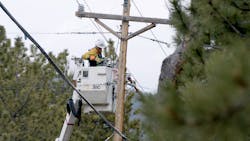CORE Electric Cooperative Taps Technology to Mitigate Wildfire Risk
T.J. Havens, CORE Electric Cooperative (CORE) 's Conifer District Manager, has wildfire on his mind every day.
"When you cover 5,000 square miles and have over 157,000 distribution poles, wildfire mitigation is extremely important," Havens says.
Due to the Conifer area's high wildfire risk, Havens and his crews focus on mitigation efforts year-round, including patrolling CORE's distribution lines through rugged terrain and on foot.
The same is true for CORE's other district offices in Woodland Park, Sedalia and Bennett. With each district's unique risks, CORE's wildfire mitigation program, CORE PROTECT, is a major effort for the electric distribution utility. And at CORE, it's personal.
"I live in a high-risk area, many of our employees do, and obviously many of our members live in these high-risk areas, so we want to do everything we can to make sure that a fire is not started, and especially not started as a result of our equipment," said Pam Feuerstein, CORE's chief operating officer.
From boots-on-the-ground pole inspections to the newest artificial intelligence technology platforms, CORE uses many tools to mitigate the risk of ignition from its equipment.Key elements of the CORE PROTECT program include:
Technology Solutions
CORE is piloting several new technology solutions that make CORE more agile and efficient in identifying and managing risk factors.
- Drones flown by FAA-licensed contractors inspect lines and poles to give crews a better visual of potential fire hazards that wouldn't be seen from the ground. Field personnel then prioritize repairs and quickly address them.
- 360-degree fire watch cameras, a pilot project with Pano AI, take multiple images per minute from towers in the field, scanning the landscape for smoke plumes. If the system identifies a smoke plume, CORE and local emergency management authorities are immediately contacted to investigate.
- Artificial intelligence satellite technology, using the Overstory platform, scans satellite imagery along CORE's right-of-ways. AI analyzes the images for potential vegetation encroachment and hazard trees to help prioritize vegetation management more efficiently and at scale.
- Smart fault indicators relay faults on CORE's powerlines back to control centers instantly so crews can address issues such as branches falling into powerlines and creating potential ignition points.
Operations Optimization
Enhanced operation and maintenance programs take already robust processes to the next level.
- System inspections of the overhead distribution system on a routine basis, both from the ground and with the help of drone technology, to identify maintenance issues that pose a risk to fire safety and reliability. All issues are prioritized and repaired according to relative risk, addressing the most hazardous conditions as quickly as possible. CORE also patrols the high-voltage transmission system even more frequently, primarily using drone and LiDAR technology, and repairs any issues found with the highest urgency.
- System hardening through line rebuilds in high-risk areas, including undergrounding of lines where site conditions allow. Stronger, taller poles designed to withstand high wind and snow conditions, 10-ft fiberglass cross-arms designed for better strength and greater spacing between lines, and cover-up of energized parts that could create a spark if contacted by wildlife or vegetation are all equipment upgrades prioritized in high-risk areas.
- Advanced weather monitoring subscriptions provide daily forecasts of wind speed, lightning, fire danger and more. CORE's System Operator sends notifications to employees and contractors when we have red flag warnings or elevated fire danger exists within CORE's service territory.
- Alternate settings are more sensitive circuit protection settings that can be used during high wind, red flag warnings and other elevated fire risk conditions. These settings allow the devices protecting the line to trip the instant there is a fault in the line, like if a tree was to fall into power lines.
Keeping Residents Safe
While CORE focuses on wildfire mitigation efforts, Colorado's Department of Regulatory Agencies offers these tips for residents to protect their property in case of wildfire:
- Use fire-resistant materials in the structure of your home, especially the roof, which is most vulnerable.
- Clear a safety zone around your home out to 30 ft and selectively remove trees, leaves, brush and pine needles. Create a zone of at least 100 ft of non-continuous fuels.
- Be sure propane or fuel tanks are at least 30 ft away from all structures.
- If you do not have access to a community water system or water hydrant, consider a water storage tank. Make sure your garden hoses reach all areas of the property and keep them visible and inaccessible areas.
- Be sure your entrance road is accessible so emergency responders are not delayed. The street address should be easily visible from the entrance to the property.
More information about CORE PROTECT can be found at https://core.coop/wildfire-mitigation/. Also look for a feature story in a future Electric Utility Operations section within T&D World magazine.
